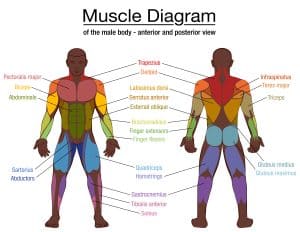Section 2: The Muscular System
Every movement of your body occurs because of muscles. The muscular system consists of more than 600 muscles specialized to help the body move and keep you alive. A muscle is an organ that can contract and relax, providing the force necessary to move the body. Muscle tissue is made up of fibers or fused muscle cells that can shorten. The shortening of these fibers is called a contraction. Each fiber is made up of smaller units called myofibrils, which are made up of thick and thin proteins called myosin and actin. It’s the interaction of these proteins that make your muscles contract. Almost all the movement in your body occurs because of muscle contraction.

In the study of the human body, we often categorize muscles as either posterior (at the back) or anterior (at the front). Posterior muscles help with movements like extending and retracting, whereas anterior muscles are involved in activities like bending, lifting, and reaching forward.
Your body has three types of muscle tissue that have different functions and are found in different locations. The skeletal muscle attaches to the bones of the skeleton by tendons, which are tough, strong connective tissue. Skeletal muscles are voluntary muscles, meaning they are muscles that you can control. Because muscle cells can only contract, not extend, skeletal muscles must work in pairs. While one muscle contracts, the other muscle in the pair relaxes to its original length. When viewed under a microscope, skeletal muscles have a striated appearance, alternating between light and dark bands.
connective tissue. Skeletal muscles are voluntary muscles, meaning they are muscles that you can control. Because muscle cells can only contract, not extend, skeletal muscles must work in pairs. While one muscle contracts, the other muscle in the pair relaxes to its original length. When viewed under a microscope, skeletal muscles have a striated appearance, alternating between light and dark bands.
A smooth muscle is found in internal organs, such as the stomach and lungs. They help move food through the stomach and help expand the lungs when you breathe. They are involuntary muscles, meaning you cannot control them, working without you knowing it. They react more slowly and tire more slowly than skeletal muscles. They look smooth under a microscope because they have no striations.
The cardiac muscle is found exclusively in the heart. It’s an involuntary muscle that never tires and contracts repeatedly. These contractions are your heartbeat.
Review:
- What is a muscle?
- Compare voluntary and involuntary muscles.
- Describe characteristics of skeletal muscles.
